
BS 40104 Retrofit assessment for domestic dwellings – Code of practice
General Comments
- Quality and consistency of retrofit assessments. This new code of practice should improve the quality and consistency of retrofit assessments across the industry. This is welcome considering the variable quality of assessments being carried out currently. A more detailed and accurate retrofit assessment should increase the standard of retrofit work carried out and reduce the risk of harm to properties.
- Implications for the cost and time associated with retrofit assessments. Whilst we welcome a drive to improve standards, the complexity of the new requirements and their potential cost implications are a concern. It is likely that this new code of practice will increase the cost of delivering retrofit assessments significantly. There is a risk that the rising cost of compliance may become a barrier to retrofit projects or contractors working on specific schemes. The new guidance will also significantly increase the time it takes to carry out retrofit assessments. This means that a larger retrofit assessor workforce will be required just to maintain current levels of delivery. The industry will need to significantly ramp up delivery of retrofit projects in order to meet the Government’s fuel poverty and net zero targets. If retrofit assessments become overly complex and costly for the industry to carry out efficiently, then this required scale up in delivery will not be achievable.
It would be useful to know if an impact assessment has been conducted on the additional cost to businesses in the sector of complying with this code because it is vital that this is not prohibitive for retrofit businesses. Ultimately, the code of practice should seek to balance the clear need to improve the quality of retrofit assessments with the practicality and cost implications for businesses of increased complexity. If more stringent requirements are introduced, it is critical that businesses are properly supported with the costs of compliance. - Transition period. The code of practice does not mention a transition period anywhere. There needs to be more clarity on the length of the transition period, when the code will come into effect, and how this will fit in with PAS 2035:2023. In order to comply with this new code of practice, the existing retrofit assessor workforce will need to undergo significant upskilling, while training courses may also need to be updated to align with the new code. It is important that the transition period accounts for these factors. Therefore, a lengthy transition period is necessary for the industry to adequately prepare for the introduction of these new requirements.
- Mandatory requirements or optional guidance. Throughout the document, “should” is used rather than “shall”. In PAS 2035, normative requirements which are mandated are referenced with “shall”, while optional guidelines are referenced as “should”. The document’s use of “should” suggests that this is optional guidance, however it needs to be clearer within the code what is mandated and what is best practice.
- Project manager and retrofit coordinator. The code of practice references the “project manager” in several cases. We assume that this relates to the retrofit coordinator role, however this is unclear as the code never mentions a retrofit coordinator. Given that the code is designed to supersede clauses 7.3 and 7.4 of PAS 2035, it would be clearer if the wording “retrofit coordinator” was used, as the designated role referenced within PAS 2035.
- Different levels of retrofit assessment. One option to mitigate cost and complexity concerns would be to permit different levels of retrofit assessments depending on the funding scheme or scope of the retrofit project. The code of practice proposes a very detailed in-depth property survey which is very useful when it comes to a deep, whole-house retrofit like those carried out under SHDF. However, for GBIS which is primarily a single-measure scheme, a retrofit assessment to this level of detail may not be necessary or cost-effective. For instance, a full retrofit assessment in line with this code of practice before carrying out a loft insulation top-up under GBIS would add significant cost and complexity to the retrofit project. If another level of retrofit assessment is introduced which is less complex than this code of practice, it should still be more comprehensive than the current retrofit assessment guidance. In this way, there would be no reduction in the standard of retrofit assessments.
Equipment (Section 4.2)
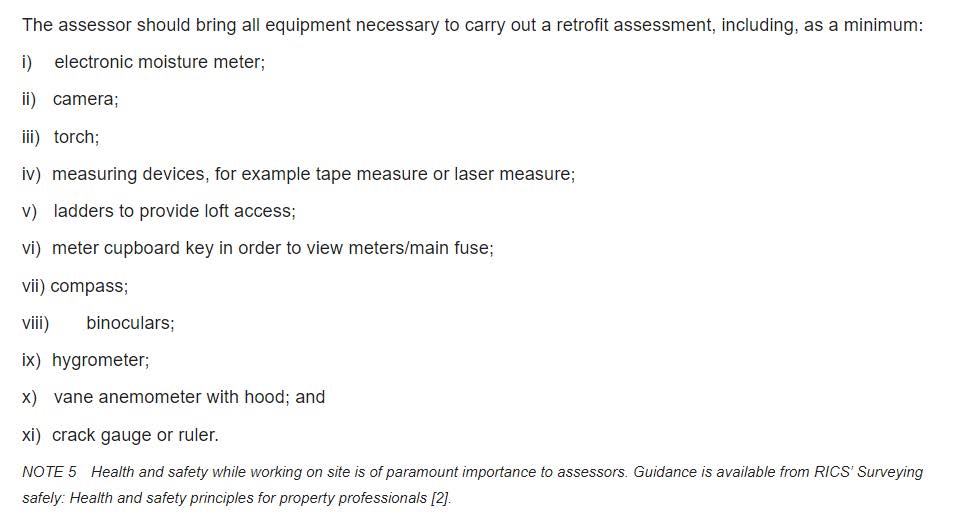
Retrofit assessors may not be familiar with all of this equipment or competent in how to use it effectively. There should be a section in the Annex explaining the equipment in detail and outlining where retrofit assessors can undergo additional training in its use (if required). This should outline the purpose of each piece of equipment (including what will it be used to measure or identify) and guidance on how to use it. It should also stipulate the standard of equipment required, as this could affect the accuracy of the results.
Context assessment (Section 5.1)
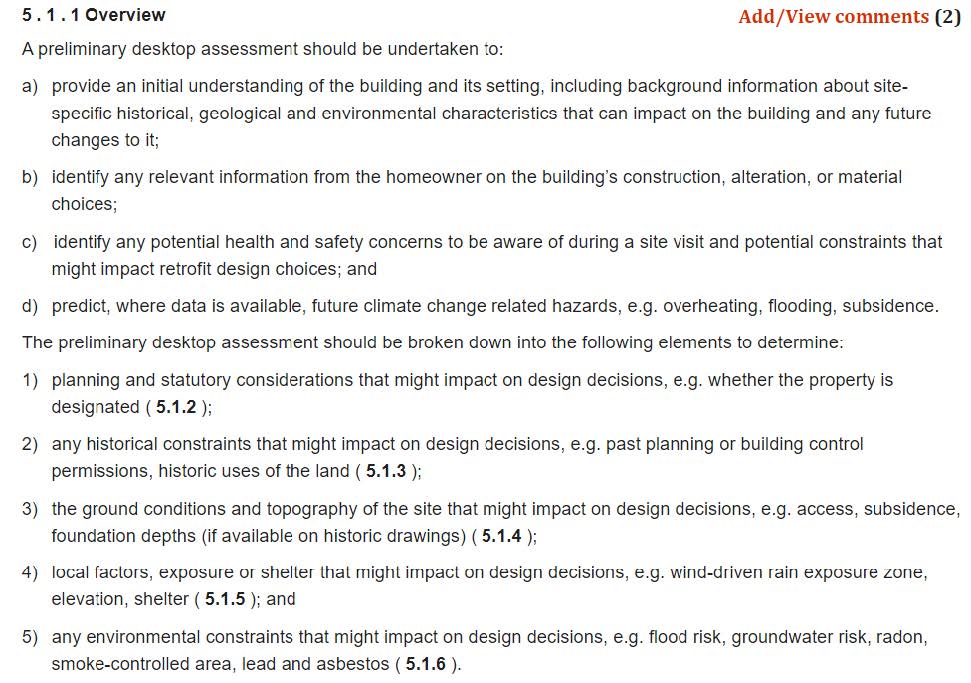
The context assessment is defined as a preliminary desktop assessment but is very broad and detailed in scope. For most government-funded schemes, a significant percentage of retrofit assessments are completed that, for a variety of reasons, never progress to an actual project. As such, the requirement for a highly detailed upfront desktop assessment will add delivery cost to existing retrofit schemes. Some aspects of it might not be necessary given that an in-depth site assessment will be carried out a later stage, hence an overly detailed desktop context assessment might duplicate effort and add unnecessary additional costs. Some of the activities within this context assessment and other sections of the code could potentially be completed after measures have been specified for a property to avoid wasting time and resources on assessments that do not progress to installation stage.
Condition assessment and condition rating (Section 6.1.1)
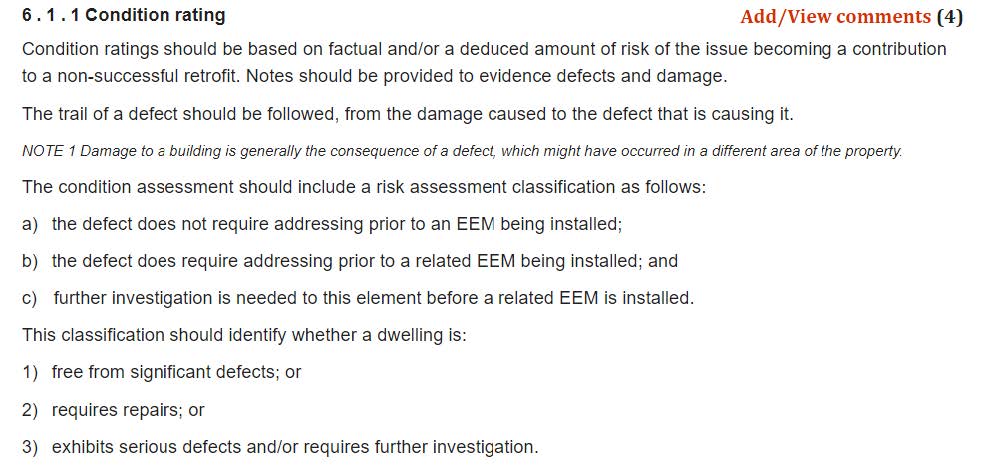
The content of this condition assessment seems closer to that of a Level 3 RICS Home Survey than the current retrofit assessment requirements. In practice, it is likely that many retrofit assessors will default to Option c) because they lack the specialist construction knowledge or data to make an informed decision on whether defects need addressing or not. Current retrofit assessors will not always have the expertise to follow ‘the trail of a defect’ and identify its root cause. In many cases, the root cause of a defect is often impossible to determine without an intrusive survey.
A thorough retrofit assessment might save time and money in the long term, as comprehensive data collection at this stage may reduce the number of additional site visits and further investigation that are required at later stages of the retrofit project. Within PAS 2035, there are a number of other surveys and inspections that need to take place. It is important that there is no duplication of effort between the code of practice and these other surveys. In order to realise the potential for efficiencies later on in the retrofit process, it is important that the results of the condition assessment and other surveys are shared with other relevant stakeholders working on the retrofit project.
A background ventilation assessment is a complex requirement which is beyond the competency of many retrofit assessors. This should be carried out by a qualified and competent specialist.
Occupancy assessment (Section 6.3.1)
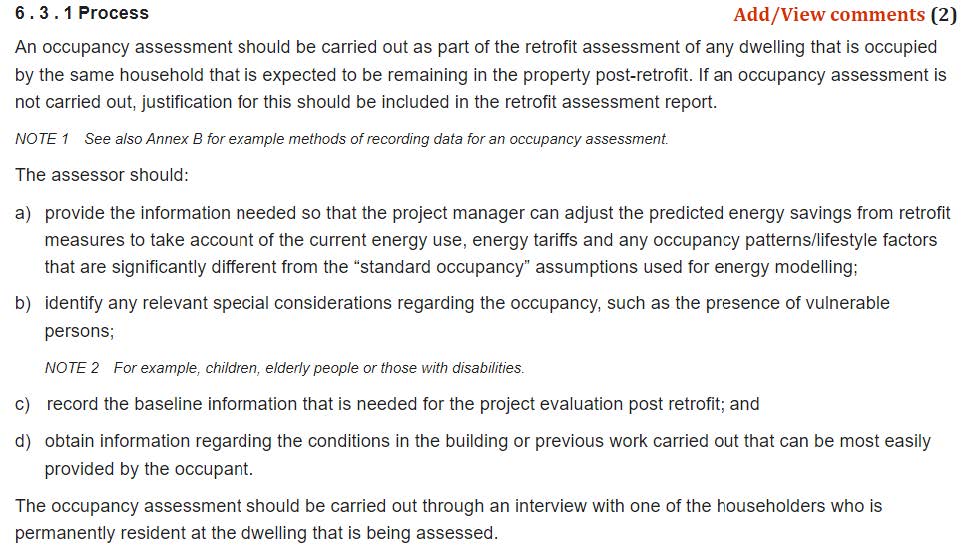
The stated purpose for an occupancy assessment is so that ‘the project manager can adjust predicted energy savings from retrofit measures’ to take account of factors such as occupancy patterns, energy use and tariffs. However, it will be very challenging to collect all of the data required for a full occupancy assessment. Many households will not have data on their energy use and tariffs over the previous 12 months easily to hand, while the innovative and fast-moving market for tariffs will further complicate efforts to accurately gather this data. Moreover, an interview with the residents may not be possible in all cases. Some tenants may not be able or willing to fully partake in an interview. Conducting an interview during every retrofit assessment could significantly increase the time and cost associated with carrying one out.
This code of practice stipulates that an occupancy assessment is required as part of every retrofit assessment. However, the imminent introduction of RdSAP10 means that there will be no formal methodology for conducting occupancy assessments, or software approval mechanism. This is likely to lead to a lack of consistency across assessments.
An occupancy assessment is useful for certain purposes, such as:
- Helping the retrofit coordinator to calculate payback periods;
- Assessing moisture management which will influence ventilation requirements;
- Identifying operational defects.
However, the additional insights gained from such a detailed occupancy assessment may not be worth the additional time and effort invested in it. At the moment, very few retrofit designs consider the results of occupancy assessments, as there are not many energy efficiency measures that would be impacted by the outcome of an occupancy assessment.
Assessor competencies (Annex C)
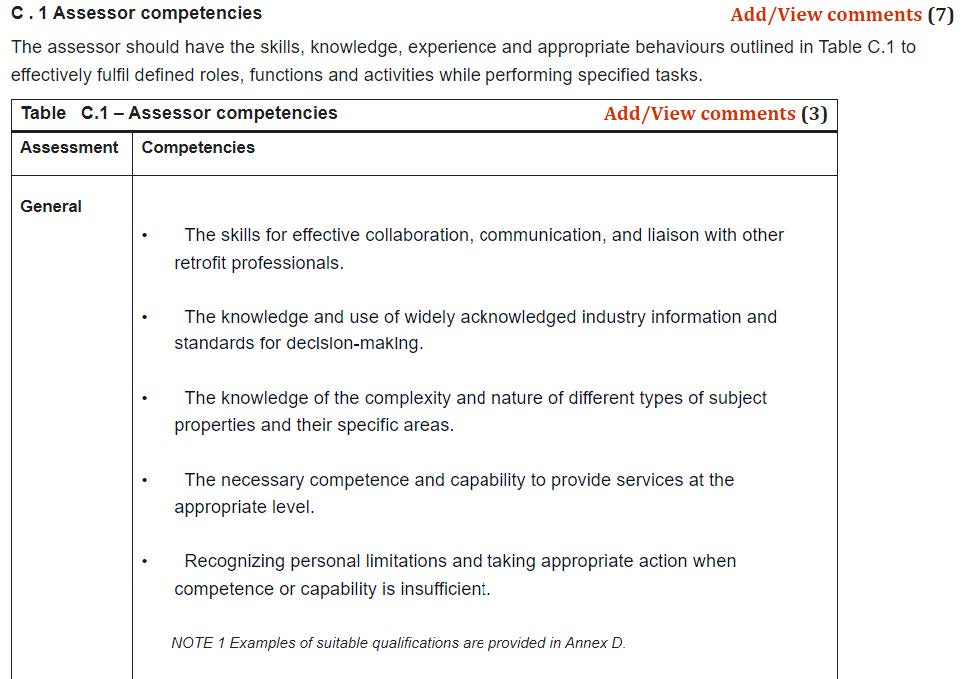
The scope of the retrofit assessor role and what they are capable of needs to be considered carefully. Some of the activities here seem to overlap with the work of the pre-installation building inspection (PIBI) and could potentially be covered within that. Other aspects require a high level of general construction knowledge which not all retrofit assessors may have, particularly those who do not come from a construction background.
The existing retrofit assessor workforce does not currently possess all of the competencies outlined in Annex C, hence a substantial upskilling and retraining of the current retrofit assessor workforce will be needed to implement it effectively. Therefore, this code of practice should be accompanied by a concerted drive to improve the training and competency of the existing retrofit assessor workforce so that it is sufficiently prepared for its introduction. This should include increased funding and support for businesses to train and upskill employees.
Qualifications (Annex D)

The level of detail within this code of practice is beyond the current content of many retrofit assessor training courses. Therefore, many existing training courses will need to be improved to align with this new code of practice.
